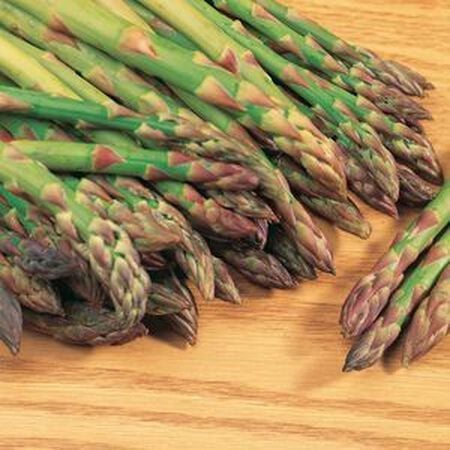Mary Washington, Asparagus Seeds
Key Attributes
Mary Washington asparagus is a classic and highly regarded variety of asparagus known for its exceptional taste and historical significance. This asparagus variety, scientifically known as Asparagus officinalis 'Mary Washington,' has a rich and earthy flavor that is often described as sweet and nutty. It's a favorite among gardeners and culinary enthusiasts for its delectable taste and tender texture when cooked.
With roots tracing back to the early 20th century, Mary Washington asparagus has a storied history. It was first developed by a breeder named J. Arthur Thomson in Maryland, USA. This heirloom variety has since gained popularity for its reliable and consistent performance in home gardens and commercial farms.
Mary Washington asparagus typically produces medium to large-sized spears that are deep green in color. It takes approximately 2 to 3 years from planting to reach maturity, at which point it can be harvested for many years to come. A single plant can yield numerous spears, making it a rewarding addition to any garden.
To grow Mary Washington asparagus successfully, it requires specific conditions. It thrives in well-drained, nutrient-rich soil with a pH level between 6.0 and 7.0. This variety prefers full sun exposure but can tolerate partial shade. Adequate spacing is essential, as mature plants can spread up to 4 feet in width. It's important to provide consistent moisture and weed control to ensure healthy growth. With proper care and attention, Mary Washington asparagus can be a delicious and enduring addition to your garden.
Key Attributes
Product Details
Weight
0.006Depth
0.1Height
4.5Width
3.25Plant Height
1-4'Botanical Name
Asparagus officinalisSeed Type
SeedAdditional Characteristics
Best Tasting VegetablesSeeds Per Gram
34Seeds Per Pound
15,200Row Spacing
30"Packet
100 SeedsSow Depth
1/2"Disease Resistance
RR, SSeeds Per Ounce
950Fruit Color
GreenBreed
Open-pollinatedSun
Full SunCubic Inches
1.4625Life Cycle
PerennialSow Method
TransplantPlant Spacing
18"Categories
AsparagusGermination
11,22,12,23,13,24,14,25,15,26,16,27,17,28,18,29,19,30,20,10,21Days To Maturity (# Days)
730Heirloom
HeirloomComponents
Growing Instructions
![]() Learning Download: How to Grow Asparagus Seeds
Learning Download: How to Grow Asparagus Seeds
Asparagus is one of the few perennial vegetable crops. The shoots are picked as young spears in the spring. Later in the season the foliage matures into an airy, fern-like cloud which changes to a golden color in the fall. Because asparagus takes up a permanent place in the garden, but can be an attractive plant, many people with space imitations use asparagus as a border or hedge plant.
Before Planting: Plants can be started from seed about 4 weeks before the last expected frost. More commonly they are grown from crowns, which are the one year old base and roots of the plants. These are planted in a trench with the roots spread out over mounded soil. The trench is gradually filled in as the plants grow.
Planting: Dig a trench 8 inches deep and wide enough to accommodate the outspread roots (about 10 inches), then space the asparagus 18 inches apart. Leave four feet between rows. Cover the roots with two inches of soil, and continue to fill in the trench as shoots grow. Be sure never to bury the green shoots completely. The trench can usually be filled by the end of the first growing season, but if not, simply continue to work on it the second year.
Watering: Water regularly, especially while young.
Fertilizer: Top dress annually with compost or mulch. Keep the patch free of competing weeds.
Days to Maturity: It takes about three years for plants to mature enough for harvesting. Prior to that plants should be allowed to grow and feed themselves.
Harvesting: In the third year, begin harvesting spears that are finger-sized and about 8″ long. You can either snap off the spears are cut them with a knife. Harvest for about 4 weeks the first year. In subsequent years you can harvest until the weather warms and the spears look spindly. Then allow the foliage to grow and feed the plants.
Tips: Asparagus is a spring crop, preferring cooler temperatures and full sun.
Shipping Schedule
Our Seed Promise
 "Agriculture and seeds" provide the basis upon which our lives depend. We must protect this foundation as a safe and genetically stable source for future generations. For the benefit of all farmers, gardeners and consumers who want an alternative, we pledge that we do not knowingly buy or sell genetically engineered seeds or plants.
"Agriculture and seeds" provide the basis upon which our lives depend. We must protect this foundation as a safe and genetically stable source for future generations. For the benefit of all farmers, gardeners and consumers who want an alternative, we pledge that we do not knowingly buy or sell genetically engineered seeds or plants.
The mechanical transfer of genetic material outside of natural reproductive methods and between genera, families or kingdoms, poses great biological risks as well as economic, political, and cultural threats. We feel that genetically engineered varieties have been insufficiently tested prior to public release. More research and testing is necessary to further assess the potential risks of genetically engineered seeds. Further, we wish to support agricultural progress that leads to healthier soils, to genetically diverse agricultural ecosystems, and ultimately to healthy people and communities.
To learn more about the "Safe Seed Pledge" please visit www.councilforresponsiblegenetics.org.

